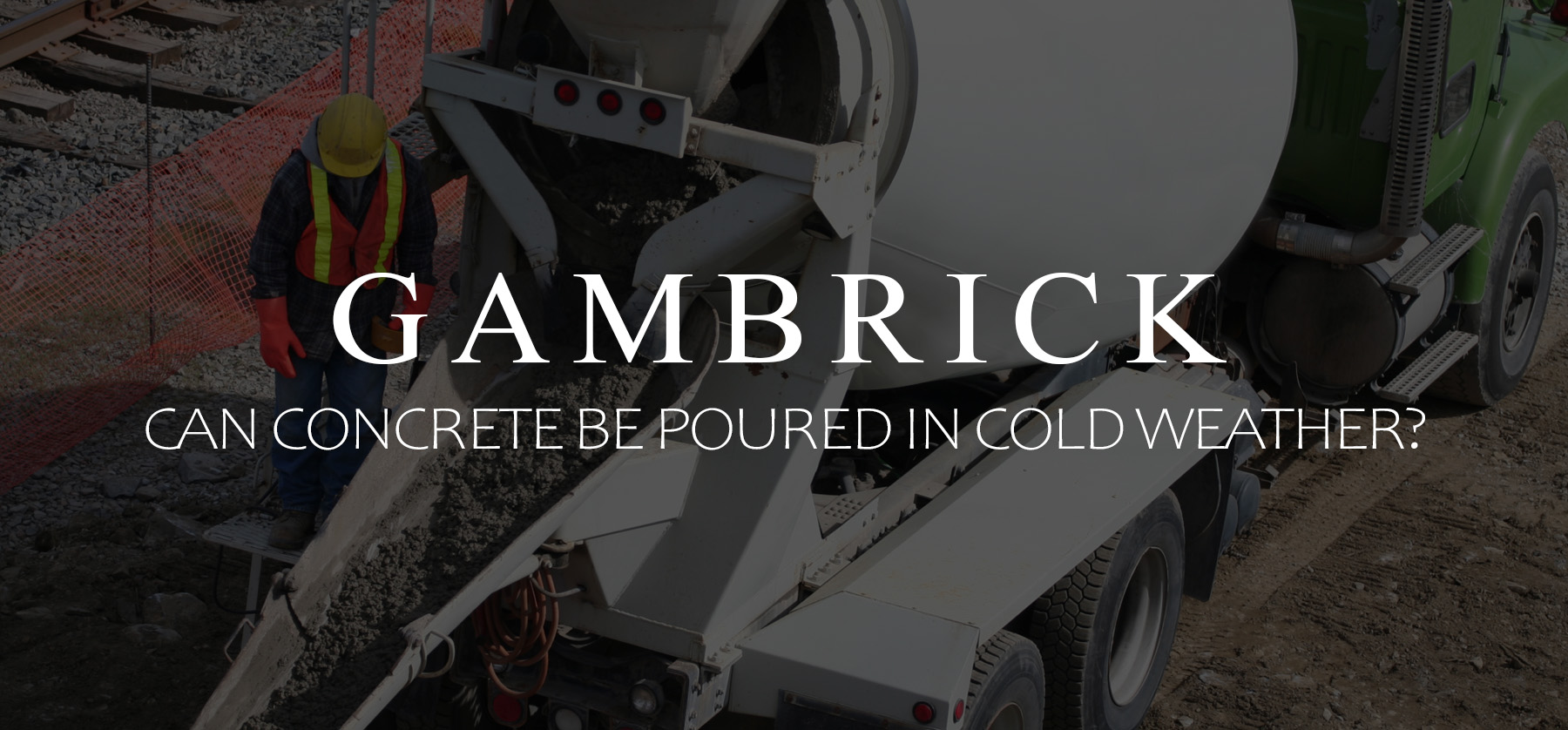Can Concrete Be Poured In Cold Weather?
The ideal temperature to pour concrete is between 40° – 60°F. This is due to the curing process. When temperatures fall below 40°F, the chemical reaction that strengthens concrete slows down which can lead to weaker concrete. And if temperatures fall below freezing, water inside the concrete can freeze and expand, resulting in cracks. Concrete can actually deteriorate back into powder when its water completely freezes because the curing process is stopped. However, concrete can be poured in cold weather if you take the right steps and work quickly. The ground can be warmed before concrete is poured. Curing blankets can be used to warm the concrete as it sets. Wind breaks can keep cold air off the concrete’s surface. And enclosures can be set up to warm the air. These are just a few of things you can do to pour concrete in cold weather.
Pouring concrete is much harder in cold weather because it must be prevented from freezing for at least 24 hours, or until it reaches 500 PSI. Concrete that freezes when it’s first poured can lose much of its strength. But concrete can be poured in extremely cold weather conditions if the right precautions are taken to control temperatures. Special techniques are used to keep concrete warm and aid in the curing process.
Ahead we’ll discuss in more detail the best ways to pour concrete in cold temperatures.
Precautions Before Pouring Concrete In Cold Weather
When temperatures get too cold, there’s no way to pour concrete without precautions. If you’re not prepared, the concrete won’t cure properly and can actually turn to dust. When temperatures fall below 20 degrees Fahrenheit, hydration slows, and possibly stops, which ruins the concrete.
The necessary chemical reactions that strengthen concrete slow significantly below 40 °F. So you must take precautions to ensure the temperatures stay warm. This takes careful planning and preparation. You can’t just wing it on the day you’re pouring and hope for the best.
Keep in mind, set times vary based on temperature and other conditions like humidity and wind. But nothing is more challenging than pouring concrete in extreme cold. But with careful planning, you can achieve good results in harsh conditions.
To handle the cold, have a plan and everything you might need on hand the day you pour. Here are some tips that can help:
- Never pour concrete on frozen ground or onto ice or snow for a few reasons. Frozen ground will settle when it thaws, cracking the concrete. The cold ground will suck heat out of the concrete too quickly. You can get crusting, the top layer of concrete hardens but the bottom stays brittle.
- If the ground is frozen you must thaw it with heaters or blankets.
- Remove all snow, ice and standing water in areas where concrete will be poured.
- Warm up anything that will come in contact with the concrete including forms.
- Have concrete blankets ready.
- Use an enclosure and portable heater to warm the site and block wind.
Concrete Loses Heat During Delivery
You can expect some heat loss during delivery.
For a one hour delivery time, the concrete’s temperature can drop about one fourth the difference between the air temperature and the concrete temperature. So if the concrete’s 60°F and the air is 20°F, in one hour it will drop about 10°F. The result is 50°F concrete at the time you pour.
This heat loss continues as you pour. If you have a one hour pour, you can expect even more heat loss. This means the concrete you’re working with after one hour is colder than the concrete you initially poured. So work fast.
Proper prep helps a lot here. Make sure everything is warm before the truck arrives and work fast. Get the concrete out of the truck and onto warm ground as fast as possible. Work the concrete and then cover it with warming blankets. If your diligent and well prepared, pouring concrete in extremely cold temperatures becomes possible.
Things To Consider When Pouring Concrete In Cold Weather
The colder it gets, the harder it is to keep work site temperatures high enough to pour concrete. Even with enclosures, heaters and insulating blankets.
- If temperatures fall below freezing, water in the concrete will freeze and expand, causing cracks and possibly deterioration.
- If temperatures fall below 40 °F but stay above freezing during set time, concrete will take much longer to reach full strength.
The American Concrete Institute (ACI) defines cold weather concreting as a period when the average daily air temperature drops below 40 degrees Fahrenheit and stays below 50 degrees Fahrenheit for more than one half of any 24 hour period for 3 consecutive days.
Before trying to pour concrete in cold weather, it’s important to prepare. I check the forecast as much as week before pour day and then every day after to adjust. Lay out a strategy to keep the site and concrete warm based on the conditions you’ll face on pour day and a few days after.
The biggest challenge you’ll face during a cold concrete project is making sure the concrete sets before it’s exposed to freezing temperatures.
Here are a few things you can try:
- Use heaters to thaw frozen ground, snow or ice.
- Keep dry materials and tools in a dry, warm location.
- Use warm water to mix cement.
- Wait until concrete has fully set to remove any framework.
- Use fast setting ingredients or additives.
- Block the wind. It sucks heat out of the concrete.
- Use blankets to keep concrete warm.
- Build a temporary enclosure with heaters to warm the air and block wind.
- Work quickly.
Maintaining The Ideal Temperature For Concrete
The most important thing when pouring concrete in cold weather is controlling and maintaining temperature. This is true of not only the concrete, but also the ground, forms, tools and air.
- If you use an enclosure and heaters to maintain proper air temperature but don’t thaw the ground, your concrete will probably crack. Cold ground sucks heat out of the concrete too quickly. It can cause uneven curing which also causes cracks.
- Wind is a big factor too. If the temperature isn’t too cold but it’s windy, heat will get sucked out of the concrete too quickly which causes cracks. Block wind with an enclosure or barriers.
- Controlling temperature after the initial pour is important too. It takes time for concrete to set and then fully cure. Concrete needs to reach at least 500 PSI before you can start removing heaters. This typically takes 24 hours.
It’s important to consider how you’ll keep concrete at the correct temperature during the initial pour and about 48 hours after. Concrete must maintain a temperature above 50 °F for approximately 48 hours after it’s poured for the chemical reaction to occur.
My two favorite options for pouring concrete in cold weather are heated enclosures and insulated blankets.
- I use an enclosure that’s both wind and water proof. Make sure it has some ventilation for the heater. Heaters cause an increase in carbon dioxide that could cause carbonation on the surface of the concrete. Unfortunately, enclosures are hard to build on large scale concrete projects. Sometimes it’s best to pour in stages so you can move the enclosure.
- Blankets are a great way to keep the concrete warm. You can use them alone or with an enclosure. If possible, I also wrap blankets around the forms to limit heat loss.
Tips For Pouring Concrete In Cold Weather
Maintaining the correct temperatures for both setting and curing is extremely important. Concrete must set before it’s exposed to freezing temperatures. This can take approximately 48 hours at above 50 °F.
You can overcome cold weather by following the tips below:
- Store concrete ingredients and tools in a warm, dry place.
- Thaw frozen ground, snow or ice with heaters.
- Use cold weather products designed to cure fast.
- Use warm water to mix your dry concrete.
- Create a hotter reaction by using extra cement (e.g. 100lb. per cubic yard). This causes concrete to hydrate quicker.
- Use squeegees or a vacuum to quickly remove bleed water. Remember, bleeding starts later and takes longer during cold weather.
- Do not remove frameworks until the concrete has cured.
- Work quickly. Preparation is key.
- Block the wind. It’ll suck heat out of the concrete.
- Cement curing is an exothermic reaction that produces some heat on its own. Contain this heat using insulated blankets.
- Build a heated enclosure.
If Concrete Freezes Too Soon
Concrete needs to resist freezing until it’s set and strong enough the resist internal freezing pressures. Typically this means about 48 hours and 500 PSI.
All concrete has water in it. As the concrete sets and cures, it evaporates water and dries. If the water inside concrete freezes, it creates pressure which breaks the cement bond which binds concrete together. Concrete has to get strong enough to resist this internal pressure before it can survive freezing temperatures. This is why temperature must be maintained after the concrete has been poured and set. Even though concrete may be hard enough to walk on, it may still be too soon to remove the heat.
Concrete that freezes before it’s set and cured to a strength that can resist expansion forces will suffer a permanent loss of strength. It could also deteriorate and turn to powder or start to flake apart. Internal freezing before concrete is cured is a terrible thing.
Early freezing can reduce the final strength of the concrete by over 50%. In some cases, if the concrete turns to powder, the concrete is completely unusable.
If the air temperature at the time of pouring is below 40 °F and if sub freezing temperatures are expected within the first 24 hours, have a strategy in place for dealing with the cold.
Cold Weather Concrete Preparation Tips
Concrete setting and curing in cold weather can be enhanced with the following practices:
- During cold weather, preheating one or more of the ingredients, water or aggregate, can ensure the proper concrete temperature is present during the pour. Ready-mix companies typically do this for you and prepare the concrete to 65 °F. But concrete loses heat as it travels and is being poured.
- Small batches of concrete mixed on site need to be warmed by you. Keep aggregate in a warm location and/or heat the water prior to mixing.
- Increasing the ratio of cement content in the concrete, or using an accelerating chemical admixture such as calcium chloride in ratios as high as 2%, can increase heat and hydration.
- Use Portland cement Type III. It helps in setting without reducing the concrete’s quality. This is important because high moisture content can cause corrosion problems in steel reinforcement.
- Avoid using fly ash or slag cement in cold weather. These materials set up slower and generate less internal heat.
- Cement curing is an exothermic reaction that produces some heat on its own. Contain this heat with blankets.
When concrete is being poured in cold weather, but not below freezing, it will take longer to develop the required strength.
Removing forms when concrete is too cold or hasn’t reached the desired strength could reduce concrete strength or cause collapse. Don’t remove the forms until you’re absolutely sure the concrete is cured strong enough to support itself.
Concrete blankets and insulated forms can help protect concrete in cold weather.
If you don’t have insulated forms, build temporary covers out of blankets to provide insulation for beams, columns, and walls.
Site Prep
Site prep during pouring can also help concrete set up and cure properly during cold weather:
- Be prepared for crews to be on site for longer. Concrete poured in cold temperatures takes more time to set and cure. This means finishing crews will have to wait longer and temperatures may need to be maintained for multiple days.
- Barriers can protect the concrete, and workers, from wind that can cause quick temperature drops and evaporation. Even when temperatures are not that cold, wind can ruin a concrete pour.
- Heated enclosures may be necessary. They can be made of wood, tarps, or plastic. Heat the inside with an electric heater. If fuel burning heaters are used, I recommend an indirect fired heater. These pump in warm air from a heater placed outside the enclosure. Another option is a hydronic system that pumps in warm water through pipes. I prefer the hot air air approach.
- Thaw and warm the ground prior to pouring concrete. Cold ground will quickly suck the heat right out of your freshly poured concrete.
The goal is to ensure your concrete is poured at a temperature of 40 °F or above and kept at that temperature until it cures strong enough to resist the cold on its own.
Temperatures for pouring and protecting concrete in cold weather are established and mandated under ACI 306. The objective of ACI 306 is to keep concrete warm, over 5 degrees Celsius, for the first 48 hours. This is when concrete strength development is most critical.
Heat Times Vary
The time you’ll have to keep the concrete heated varies based on the type of concrete you’re pouring and what it’s used for.
- High early strength concrete that won’t be exposed to freeze thaw cycles require just a day above 40 °F.
- A concrete foundation or other structure that will carry high loads can require as much as 20 days above 40 °F.
Your architect or engineer will tell you how long the concrete needs to be heated for and to what temperature.
Under no circumstances should concrete be allowed to freeze within the first 24 hours after pouring.
Cold Weather Concrete Curing Tips
There are a few techniques you can use during the curing process to ensure it reaches maximum strength:
- Leave forms in place as long as possible. They can retain heat and help prevent concrete from drying too quickly. Corners and edges are most vulnerable areas.
- Steam can be pumped into an enclosure to prevent concrete from drying too quickly. Low humidity levels are common during cold weather so this is often a concern.
- Wait until bleed water has evaporated before finishing. Concrete poured in cold weather has a slower setting and curing time, so bleeding will start later than expected. Be prepared for more bleed water than is found in an average pour.
- While concrete is curing, check the internal temperature using an infrared temperature gun. Make sure the concrete is maintaining a temperature of at least 40 °F.
- When in doubt, keep the concrete warm. One of the biggest mistakes I see is masons removing the heat too soon. There’s no rush. Pouring concrete in cold weather is a slow process.
- Don’t let concrete cool too rapidly by removing the enclosure or blankets too fast. Remove your heat sources slowly which acclimates the concrete to the cold temperatures. A sudden, extreme drop in temperature isn’t good for the concrete.
- In extremely cold areas, use a breathable concrete sealant that allows evaporation.
General Protection
Most of this article discusses how to pour and care for the concrete in cold weather. But don’t forget about worker safety. There are all sorts of precautions you should consider when working in extreme conditions.Here are just a few I use:
- Water and cold weather don’t generally mix. If you or your workers get wet, have a warm place ready for them to change along with new clothes and safety gear like gloves and boots.
- Set up a heated bathroom.
- Bring safety gear. You wouldn’t normally think of coats as safety gear but in extreme cold they are. Gloves, boots, hats and glasses are all good to have on a cold job site.
- I prefer tinted safety glasses when working in the cold, especially if there’s snow on the ground. Looking at glare from the snow all day can irritate your eyes.
- Don’t let extremities get wet. This can lead to frost bite.
- Be prepared to deal with falls. I’ve poured concrete on ground covered in snow and ice and workers have gotten hurt.
- Hand warmers come in handy, Especially when it comes time to trowel.
- Block the wind. This is important for the concrete but also for the workers. It’s easy to dress warm, but freezing cold wind can be an issue no matter what you put on. You’d be amazed how cold it can get and still be comfortable for work as long as there’s no wind.
- I always bring warm coffee or soup in a thermos.
- Bring an insulated cooler. Your drinks will freeze if it’s cold enough. And remember to stay hydrated. I’ve seen just as many people get dehydrated in cold as in hot weather.
Summary: Can Concrete Be Poured In Cold Weather?
The ideal temperature to pour concrete is between 40° – 60°F. This is due to the curing process. When temperatures fall below 40°F, the chemical reaction that strengthens concrete slows down which can lead to weaker concrete. And if temperatures fall below freezing, water inside the concrete can freeze and expand, resulting in cracks. Concrete can actually deteriorate back into powder when its water completely freezes because the curing process is stopped. However, concrete can be poured in cold weather if you take the right steps and work quickly. The ground can be warmed before concrete is poured. Curing blankets can be used to warm the concrete as it sets. Wind breaks can keep cold air off the concrete’s surface. And enclosures can be set up to warm the air. These are just a few of things you can do to pour concrete in cold weather.
Pouring concrete is much harder in cold weather because it must be prevented from freezing for at least 24 hours, or until it reaches 500 PSI. Concrete that freezes when it’s first poured can lose much of its strength. But concrete can be poured in extremely cold weather conditions if the right precautions are taken to control temperatures. Special techniques are used to keep concrete warm and aid in the curing process.
If you have any questions or comments about pouring concrete in cold weather, Email any time.





















